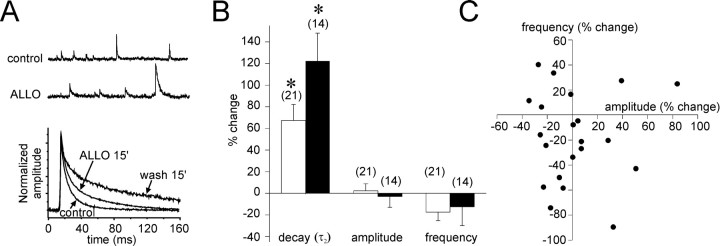Fig. 1.
Allopregnanolone increases the decay time constant of IPSCs. A,Top, Spontaneous IPSCs recorded in control conditions (control) and after a 15 min bath application of allopregnanolone (ALLO; 1 μm) that caused a substantial increase in the IPSC decay. Bottom, Superimposed averages of IPSCs from the same cell recorded over 3 min periods in control conditions (control), after 15 min of allopregnanolone application (ALLO 15′), and after 15 min of washout of the allopregnanolone (wash 15′). The amplitudes of the mean IPSCs were normalized to control amplitudes. The slow IPSC decay time constant increased by 51.2%, from 31.4 to 44.5 msec, after 15 min in allopregnanolone and increased further after the 15 min washout to stabilize at 272% of the control value (117.2 msec).B, The changes in IPSC decay, amplitude, and frequency measured after a 15 min bath application of allopregnanolone (1 μm;openbars) and a 15 min washout period (filledbars). The average of the slow decay time constant showed a significant increase in allopregnanolone (+67.3 ± 14.8%) and continued to increase during the 15 min washout period (+122.3 ± 25.8%). The average changes in IPSC amplitude (+2.3 ± 6.5%) and frequency (−17.5 ± 7.9%) were not significant. The numbers in parenthesesindicate the number of cells tested. C, Scatter plot of changes in IPSC amplitude and frequency in individual cells. Although some cells showed a change in one or the other of the two parameters after a 15 min application of allopregnanolone (1 μm), there was no correlation between the two in individual cells, nor were the changes consistent across the population.

